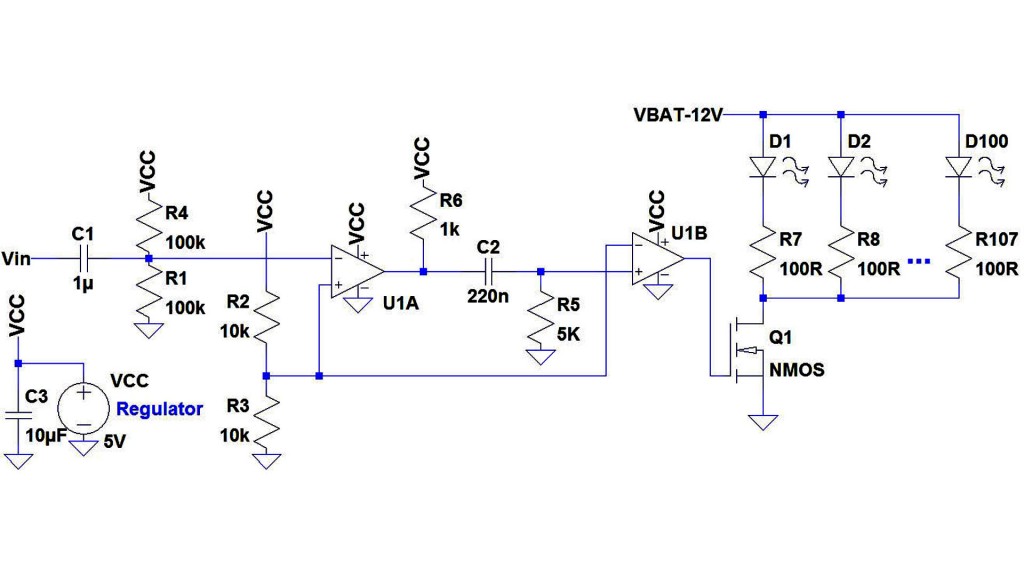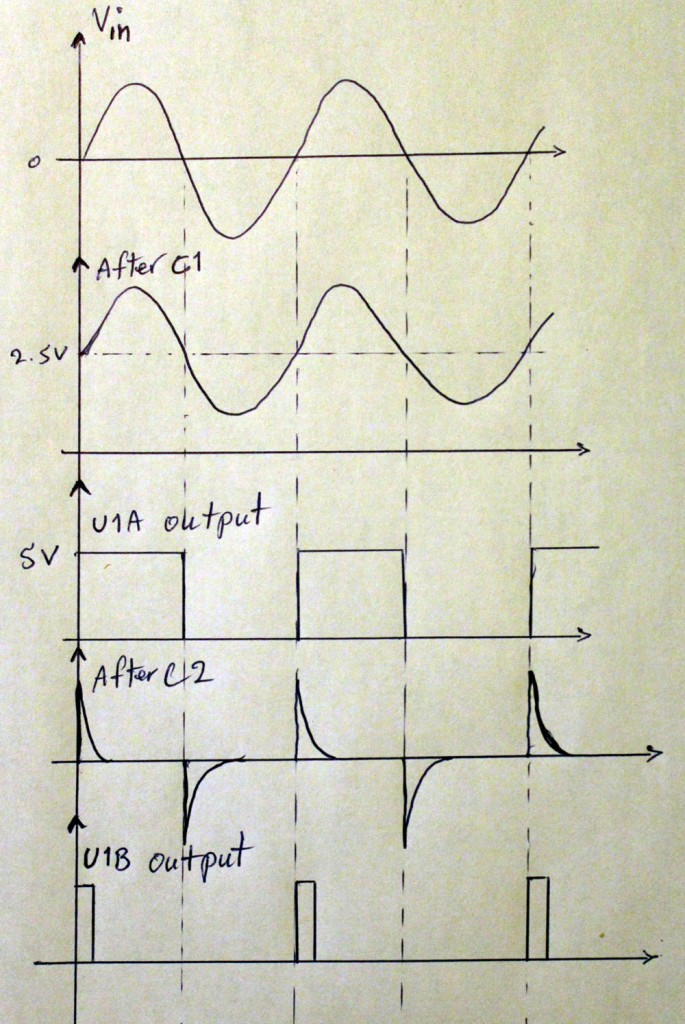Wouldn’t it be nice to see the water actually levitating in mid air with naked eyes? It is actually possible:
In my previous video I showed how matching the frame rate of the camera and vibration frequency of water can cause the camera to record the water levitating. But that wasn’t visible to the eye. But using a strobe light it is possible to create the illusion that the water is levitating, visible to the eye. A proper strobe light like LED can light up the water for a very short period of time every period. The concept of this levitation is similar to what I explained in my previous post.
To make this work, the strobe light should be on for only a very short period of time every period. The shorter the on-time is, the sharper and less fuzzy the water drops will look like. Because the light would sample a smaller period of time in which the water moves less. In my design, the on-time of the light is less than 1mS (around 0.7mS) every period.
I have already told you how to make a vibrator using a speaker and how to drive it in a previous post. So now all you need to know is how to make and drive a strobe light. Below is the schematic of the circuit.
And here’s the part list of the components:
- LED: Everlight Elec., 334-15/X1C5-1QSA, Or any white LED, the brighter the better
- Comparator: Any >5V supply comparator with push-pull output would do
- Transistor: Fairchild, FQP30N06, or similar power FET capable of >10A
- Regulator: MCC, 78L05BP or similar
- All other parts are generic
The circuit uses an input generated from a signal generator, or in my case the audio jack of a smart phone with a signal generator app similar to what I explained in my previous post.
There are a few stages in the design. The first one including U1A is a simple comparator. C1 gets rid of the DC component of the signal coming from the signal generator and then that signal, riding on 2.5V (due to R1, R4 divider), will be compared to a DC 2.5V (from R2, R3 divider) and the output of U1A will be a 0 to 5V square wave. This is done do make a uniform square wave signal because the phone may not be able to generate a good and consistent square wave.
The next step is the R-C circuit of R5, C2 that is a high pass filter. The intention of this filter is to make the signal width much thinner, so that it is only high for a very short period of time. Adjusting the R-C values would affect the width of the pulse. R6 helps boost the high side current drive of U1A. Now to make this signal shaped as a proper digital wave, it passes through a second comparator stage. Below is how the signals look like passing through the stages.
Now the last stage is a power FET transistor. A high at the FET’s gate will turn it on like a switch. This FET needs to be strong enough to be able to handle the high current running through the LEDs. This driving circuit is not very power efficient. There are much more efficient circuits, but this should do the trick for this experiment. Here are some notes in designing the circuit.
- If the light is on for 1mS and the maximum frequency provided is 100Hz, then the period is 10mS and the light is on 10% of the time.
- This means that we can actually drive the LED 10 times its nominal current rating. (make sure to read the datasheet for recommended maximum pulse current).
- The higher current will provide more light. We need it as our LED is only on 10% of the time at best.
- The white LEDs usually have 3V to 4V across them when on.
- The series resistor for every LED is calculated to provide maximum current required. The average current will be 10% the maximum at 100Hz. The lower the frequency, there will be less current draw as the amount of time the light is on is fixed while the period increases.
- The FET transistor must be rated to be able to easily handle this average current. In my case the average current would be around 1A max (~10A pulse currents).
Here you have it. Let me see if you can make a fancy water fixture. There is one problem with this fixture that is the room needs to be dark, or at least the water needs to be illuminated only by the strobe light and otherwise the rest of the water that should normally be dark and invisible, would light up like I showed in the video. But even is the room is not totally dark, it might be interesting to see a constant flow of water, within which some water drops are seemingly traveling differently.
And… don’t pour water on your electronics, especially if you decide to run it from 110V or 220V rather than the drill batteries!
[EDIT] Additional Notes:
There might be a little confusion here I like to clarify. VBAT-12V is not -12V, the “-” is just a spacer between VBAT and 12V. It is actually a +12V and the other side of battery is ground. But then the battery has a center contact at +6V. Naming the voltage of the circuit nodes is arbitrary. The fact is that there are three nodes, one with the lowest voltage, the other one 6V above the lowest and the other one 12V above the lowest. Now you can call them 0V, 6V and 12V, or like my other video -6V, 0V and +6V. It is how you design with them that gives them a meaning.
The regulator is a device that takes an input voltage, I called VCC here, which in my case is 5V. The regulator can take an input voltage range, for example 7V to 16V and generate a fixed output of 5V. I haven’t shown the regulator properly in the diagram. It is in general a 3 pin device with an input, an output and a ground connection. So the input in this case connects to VBAT-12V and generates a fixed 5V called VCC. A fixed voltage is used to ensure consistent behavior of the circuit, as well as making sure that the circuit wouldn’t see an unwanted high voltage.
VIN can be the positive or negative of the audio jack. Since there is no initial ground reference between the two devices (cell phone and the circuit) and there is no DC voltage between the output lines of the cell phone, the two lines can be connected anyway makes you happier. But normally to make it rational, the negative output is connected to ground and the positive is connected to VIN.


